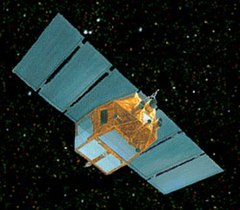Beppo-SAX

Artist's conception of BeppoSax in space
(credit: the Italian Space Agency (ASI) and BeppoSAX Science Data Center (SDC)) |
|||||||||||
| Names | Satellite per Astronomia X | ||||||||||
|---|---|---|---|---|---|---|---|---|---|---|---|
| Mission type | X-ray astronomy | ||||||||||
| Operator | ASI / NIVR | ||||||||||
| COSPAR ID | 1996-027A | ||||||||||
| SATCAT no. | 23857 | ||||||||||
| Website | www.asdc.asi.it/bepposax/ | ||||||||||
| Mission duration | 7 years | ||||||||||
| Spacecraft properties | |||||||||||
| Manufacturer |
Alenia CNR |
||||||||||
| Launch mass | 3,100 lb (1,400 kg) | ||||||||||
| Payload mass | 1,060 lb (480 kg)ù | ||||||||||
| Dimensions | 3.6 m × 2.7 m (11.8 ft × 8.9 ft) | ||||||||||
| Power | 800 W | ||||||||||
| Start of mission | |||||||||||
| Launch date | 04:31, April 30, 1996 | ||||||||||
| Rocket | Atlas-Centaur AC-78 | ||||||||||
| Launch site | LC-36B, Cape Canaveral | ||||||||||
| End of mission | |||||||||||
| Disposal | decommissioned | ||||||||||
| Deactivated | 13:38, April 30, 2002 | ||||||||||
| Decay date | 22:06, April 29, 2003 | ||||||||||
| Orbital parameters | |||||||||||
| Reference system | Geocentric | ||||||||||
| Regime | Low Earth | ||||||||||
| Eccentricity | 0.00136 | ||||||||||
| Perigee | 575 km (357 mi) | ||||||||||
| Apogee | 594 km (369 mi) | ||||||||||
| Inclination | 4 degrees | ||||||||||
| Period | 96.4 minutes | ||||||||||
| Epoch | 30 April 1996, 03:31 UTC | ||||||||||
| Main telescope | |||||||||||
| Type | approximated Wolter type I Coded mask telescope (WFC) |
||||||||||
| Diameter | 6.8 to 16.2 cm (2.7 to 6.4 in) | ||||||||||
| Focal length | 1.85 m (6.1 ft) | ||||||||||
| Collecting area | 22 to 600 cm2 (3.4 to 93.0 sq in) | ||||||||||
| Wavelengths | X-ray to Gamma ray, 12 nm–4 pm (0.1–300 keV) | ||||||||||
| Instruments | |||||||||||
|
|||||||||||
BeppoSAX was an Italian–Dutch satellite for X-ray astronomy which played a crucial role in resolving the origin of gamma-ray bursts (GRBs), the most energetic events known in the universe. It was the first X-ray mission capable of simultaneously observing targets over more than 3 decades of energy, from 0.1 to 300 kiloelectronvolts (keV) with relatively large area, good (for the time) energy resolution and imaging capabilities (with a spatial resolution of 1 arc minute between 0.1 and 10 keV). BeppoSAX was a major programme of the Italian Space Agency (ASI) with the participation of the Netherlands Agency for Aerospace Programmes (NIVR). The prime contractor for the space segment was Alenia while Nuova Telespazio led the development of the ground segment. Most of the scientific instruments were developed by the Italian National Research Council (CNR) while the Wide Field Cameras were developed by the Netherlands Institute for Space Research (SRON) and the LECS was developed by the astrophysics division of the European Space Agency's ESTEC facility.
BeppoSAX was named in honour of the Italian physicist Giuseppe "Beppo" Occhialini. SAX stands for "Satellite per Astronomia a raggi X" or "Satellite for X-ray Astronomy".
X-ray observations cannot be performed from ground-based telescopes, since Earth's atmosphere blocks most of the incoming radiation.
...
Wikipedia
